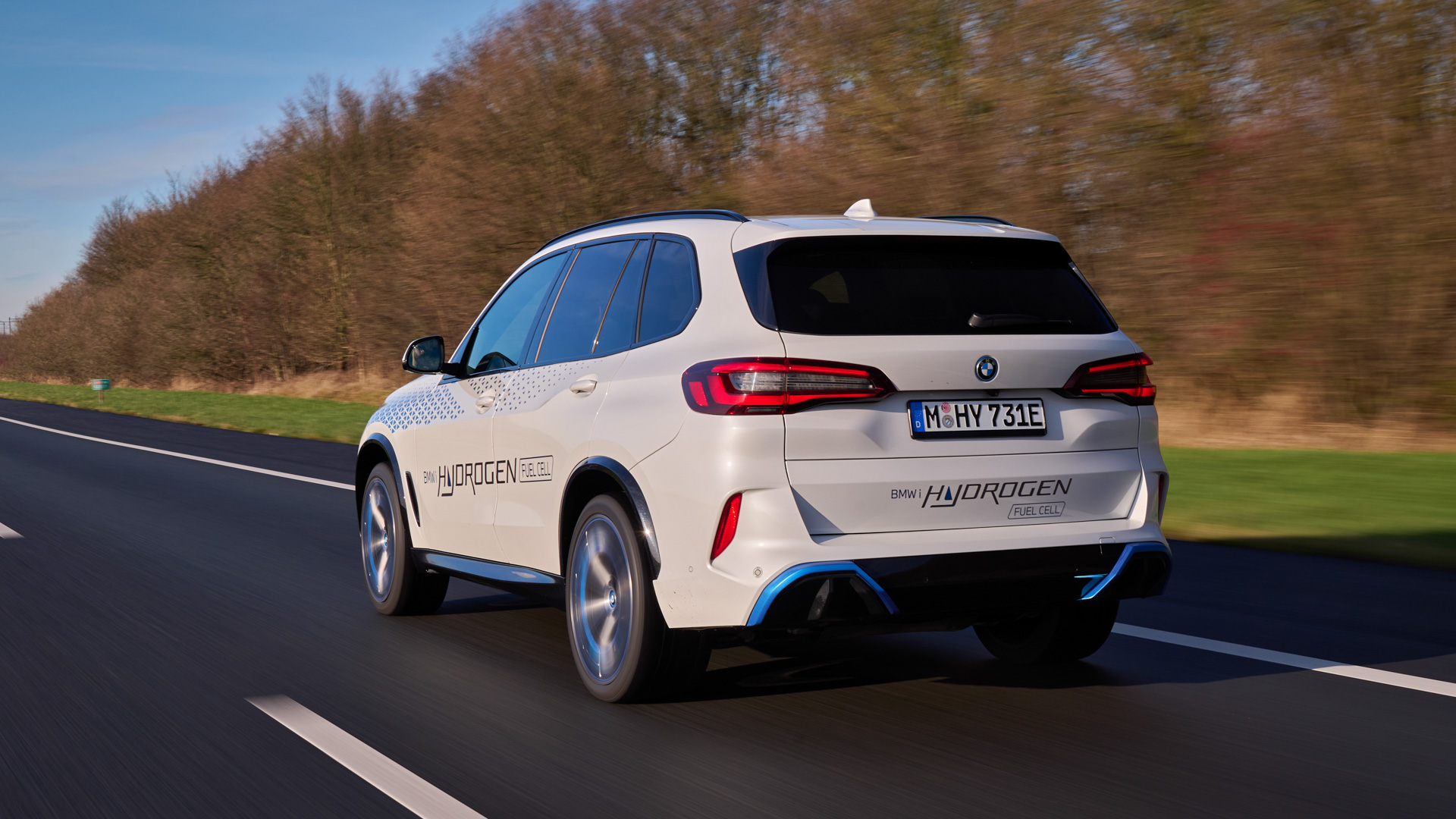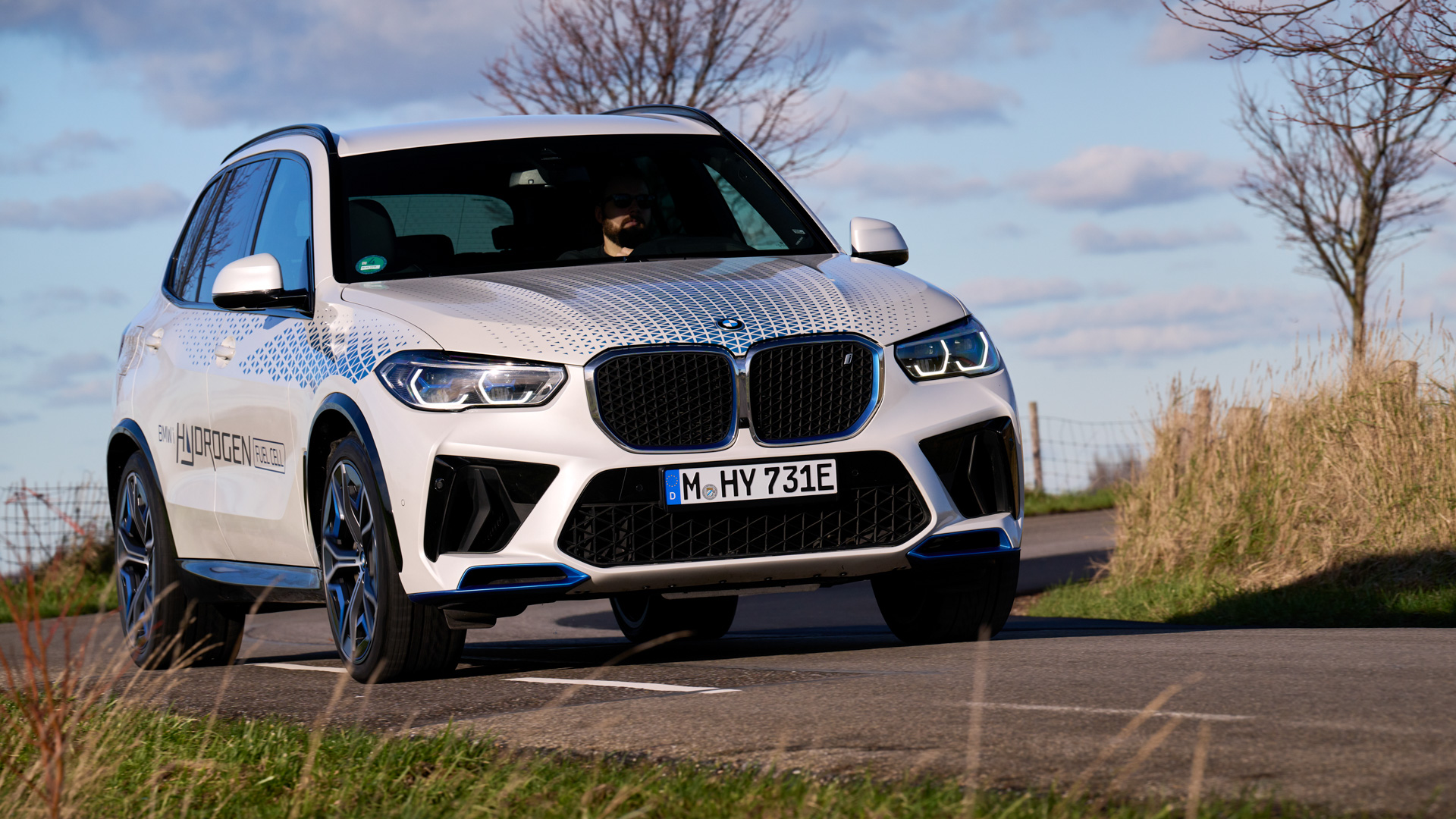The BMW iX5 Hydrogen proves that batteries aren’t the only answer
Do hydrogen cars have a future? I drove this BMW prototype to find out


Step inside, start driving and you would be forgiven for thinking this is merely BMW’s next electric vehicle. A battery-powered version of the X5 with which we’re all familiar.
The car drives just as you would expect an electric X5 to. There are two electric motors driving all four wheels, producing 401 horsepower and accelerating the car to 60 mph in around six seconds. The range is a claimed 310 miles, and although it’s a bit on the soft side at low speeds, the car sharpens up quite nicely when going more quickly, while serving up plenty of comfort and the calming silence electric car drivers are all familiar with.
But this isn’t BMW’s next electric car. It is one of 100 prototypes used to evaluate whether hydrogen fuel cell vehicles have a viable future.
How hydrogen cars work

The electricity used to drive those motors doesn’t come from a huge battery in the floor of the car.
Instead, an onboard hydrogen fuel cell is used to create electricity with oxygen captured from the surrounding air, which then powers the motors via a small, circa-2.0 kWh battery. Performance is generally the same as a conventional battery-powered EV and a small amount of water is the only emission.
Before it is pumped into the car at a fuelling station, hydrogen is separated from oxygen in water using an electric current in a process called electrolysis. Providing that electricity comes from a renewable source, like solar panels or a wind farm, this so-called ‘green hydrogen’ fuel is entirely sustainable. Even if the hydrogen is created used fossil fuels, there is still the benefit of the car producing zero toxic tailpipe emissions.
Transported to fuelling stations by truck, like petrol and diesel, hydrogen is stored in huge tanks behind the pumps themselves at a pressure of 500 bar. It can then be dispensed into vehicles at a higher pressure — 700 bar in the case of the iX5 — and a refill takes just three or four minutes.
Get all the latest news, reviews, deals and buying guides on gorgeous tech, home and active products from the T3 experts
Because it uses electric motors, the iX5 Hydrogen drives just like any other EV, but with a couple of major improvements. The range does not decrease in cold weather, as it does with battery electric vehicles (BEV), and it is not hampered when towing a trailer either.
Not for sale (yet)

BMW isn’t new to hydrogen cars. It revealed its first hydrogen concept back in 2019 and since then has tested vehicles across Europe. The iX5 Hydrogen driven here was revealed in 2021 and a fleet of around 100 examples is currently embarking on a global test programme to discover if hydrogen cars really do make sense. BMW did a similar thing with a fleet of electric Mini prototypes way back in 2009, before putting its first electric car, the i3, into production four years later.
If its big hydrogen test is a success, you can expect to see both battery and hydrogen versions of the electric iX5 going on sale later this decade.
BMW is keen to point out how hydrogen isn’t a rival to battery power, but instead represents an alternative option when it comes to electric cars. In an ideal world, BMW says customers will decide which model of car they want, then pick whether they want one powered by batteries or one fuelled with hydrogen. Both should drive in broadly the same way, and be priced similarly too.
As for weight, BMW says hydrogen cars are lighter than an equivalent battery-powered car – due to the lack of a huge battery that can often weigh more than 500 kg – and are roughly the same as a similarly-sized plug-in hybrid.
How does the iX5 Hydrogen drive?

The iX5 Hydrogen immediately feels like every other electric car you've ever driven, with a nice amount of torque to get you off the line and 60 mph arriving in about six seconds.
Inside, the cabin is just what you’d expect from an electric BMW X5. The only difference is how the digital driver display shows the percentage of Hydrogen remaining in the tank, instead of petrol, diesel or battery charge, and the words ‘Hydrogen Fuel Cell’ are written across the display.
The car we drove indicated 276 miles of range from a hydrogen tank that was about 75 percent full. For now it’s not clear how driving style affects consumption – like how a long motorway cruise at a European-friendly 80 mph takes chunks out of a BEV’s range – but we like how a hydrogen car’s range is unaffected by cold weather.
BMW says these cars are better-suited to towing, too, with the extra weight of a trailer or caravan not as likely to destroy range as they do with battery cars.
Refuelling at a hydrogen station

Looking and driving like a battery-powered car is all well and good, we hear you say, but what about the lack of hydrogen stations? It’s a fair concern. For now this is the biggest sticking point for hydrogen, and the stats don’t make for good reading.
According to data collected by the Hydrogen Council and shown to us by BMW, there are just 12 hydrogen filling stations in the UK, under 300 across Europe and the Middle East, about 100 in the US and only five in Australia.
This situation is due to improve, with the European Union pledging to install a station every 200 km (124 miles) by 2030, totalling more than 600 stations. A few thousand are also planned for the US by the same year.
This infrastructure is primarily being built for an expected increase in demand for hydrogen powered trucks, buses and other large vehicles for which big, heavy batteries don’t make sense. BMW hopes its future customers will happily use the same hydrogen stations as those commercial vehicles, since they refill their hydrogen tanks in the same way.
During our drive of the iX5 we stopped at a hydrogen station close to Heathrow Airport and operated by Air Products. The fuel is currently priced at about £20 per kg, meaning the BMW’s tank would cost £120 to fill. Not cheap, given the circa-310 miles of range, but economies of scale will surely bring this down over the coming years – assuming hydrogen vehicles prove popular, of course.
The pump looks and feels a lot like a traditional petrol or diesel one, but with a mechanism for locking into place while fueling. The whole operation can be completed one-handed, payment is made with the tap of a contactless credit or debit card, and there’s no need (for now at least) to use a smartphone app, carry an RFID fob or hand over any personal data.
It’s quick and easy, but I wonder if buyers of hydrogen cars will all be willing to share fuelling stations with trucks and buses – stations that don’t even have a kiosk or a toilet, let alone a decent supermarket with a coffee machine.
Such stations will no doubt arrive when (if) hydrogen cars take off, but for now it feels like a necessary industrial process rather than a ground-breaking retail experience.
The early verdict

There are still a lot of unanswered questions when it comes to hydrogen cars. The case for hydrogen trucks and buses seems more obvious, given how the energy density of batteries isn’t currently suitable for heavy vehicles requiring a long range.
It is also plausible that early adopters of hydrogen cars will be happy to use the fuelling network being built for large vehicles. Hydrogen also makes sense in countries where creating a high-speed EV charging network is years, perhaps even decades, away due to limitations with existing electrical infrastructure. In those cases, hydrogen can be delivered to modified petrol stations using trucks that already exist.
This approach feels far more plug-and-play than BEVs and their need for chargers, but there is still a significant chicken-and-egg situation to overcome. BMW is right to set itself the goal of offering future electric cars with either battery or hydrogen power, but doing so will require huge investments without a) the certainty that fuelling stations will appear quickly enough, and b) knowing enough consumers will demand hydrogen over battery power to make commercial sense.
For now, we applaud BMW for forging ahead with the iX5 Hydrogen test and look forward to seeing the results in a few years’ time.
Alistair is a freelance automotive and technology journalist. He has bylines on esteemed sites such as the BBC, Forbes, TechRadar, and of best of all, T3, where he covers topics ranging from classic cars and men's lifestyle, to smart home technology, phones, electric cars, autonomy, Swiss watches, and much more besides. He is an experienced journalist, writing news, features, interviews and product reviews. If that didn't make him busy enough, he is also the co-host of the AutoChat podcast.
